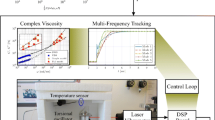Abstract
Real-time monitoring of the physical properties of liquids, such as lubricants, is a very important issue for the automotive industry. For example, contamination of lubricating oil by diesel soot has a significant impact on engine wear. Resonant microstructures are regarded as a precise and compact solution for tracking the viscosity and density of lubricant oils. In this work, we report two different resonators for the monitoring of oil dilution with diesel fuel; one device was designed to vibrate in out-of-plane modes (12-mode or 14-mode), while the other micro-plate was actuated in the first extensional in-plane mode. To determine from the measurements the resonance parameters of interest (resonance frequency and quality factor), an interface circuit was implemented and included within a closed-loop scheme. Two types of oscillator circuits were tested, a Phase-Locked Loop based on instrumentation and a more compact version based on discrete electronics, showing similar resolution. A model with fitting parameters was validated allowing for the determination of the viscosity and density of the fluids under test, for which only a small amount of test liquid, in the range of 0.5 ml, was required. Our results demonstrate the performance of the resonators in oils with viscosity up to 90 mPa s. For such viscosity, the quality factor measured at 25 °C was 7 for the 12-mode, 19 for the 14-mode and 16 for the extensional mode. The best resolution for both fluid material parameters was obtained in the 14-mode, showing 3.92 × 10−5 g/ml for the density and 1.27 × 10−1 mPa s for the viscosity, in pure lubricant oil SAE 0W30. Finally, the resonator with the best result (14-mode) was also tested in continuous-flow measurements, showing a resolution of 0.5 ppm of diesel contamination in a pure lubricant oil SAE 2.5 W.










Similar content being viewed by others
References
Agoston A, Ötsch C, Jakoby B (2005) Viscosity sensors for engine oil condition monitoring—Application and interpretation of results. Sens Actuators A Phys 121:327–332. doi:10.1016/j.sna.2005.02.024
Aldajah S, Ajayi OO, Fenske GR, Goldblatt IL (2007) Effect of exhaust gas recirculation (EGR) contamination of diesel engine oil on wear. Wear 263:93–98. doi:10.1016/j.wear.2006.12.055
Dufour I, Lemaire E, Caillard B et al. (2014) Effect of hydrodynamic force on microcantilever vibrations: applications to liquid-phase chemical sensing. Sens Actuators B: Chem 192:664–672. doi:10.1016/j.snb.2013.10.106
Gatti PL, Ferrari V (2001) Applied structural and mechanical vibrations. doi:10.1016/S0141-0296(00)00050-X
George S, Balla S, Gautam M (2007) Effect of diesel soot contaminated oil on engine wear. Wear 262:1113–1122. doi:10.1016/j.wear.2006.11.002
Heinisch M, Voglhuber-Brunnmaier T, Reichel EK et al (2014) Reduced order models for resonant viscosity and mass density sensors. Sens Actuators A Phys 220:76–84. doi:10.1016/j.sna.2014.09.006
Ho GK, Abdolvand R, Sivapurapu A et al (2008) Piezoelectric-on-silicon lateral bulk acoustic wave micromechanical resonators. J Microelectromechanical Syst 17:512–520. doi:10.1109/JMEMS.2007.906758
Ivaldi P, Abergel J, Matheny MH et al (2011) 50 nm thick AlN film-based piezoelectric cantilevers for gravimetric detection. J Micromechanics Microengineering 21:085023. doi:10.1088/0960-1317/21/8/085023
Jakoby B, Member S, Vellekoop MJ (2011) Physical sensors for liquid properties. IEEE Sens J 11:3076–3085
Kucera M, Wistrela E, Pfusterschmied G et al (2014) Characterization of a roof tile-shaped out-of-plane vibrational mode in aluminum-nitride-actuated self-sensing micro-resonators for liquid monitoring purposes. Appl Phys Lett 104:10–15. doi:10.1063/1.4882177
Lapuerta M, Hernández JJ, Oliva F (2014) Strategies for active diesel particulate filter regeneration based on late injection and exhaust recirculation with different fuels. Int J Engine Res 15:209–221. doi:10.1177/1468087412468584
Manzaneque T, Ruiz V, Hernando-García J et al (2012) Characterization and simulation of the first extensional mode of rectangular micro-plates in liquid media. Appl Phys Lett 101:151904. doi:10.1063/1.4758470
Manzaneque T, Ruiz-Díez V, Hernando-García J et al (2014) Piezoelectric MEMS resonator-based oscillator for density and viscosity sensing. Sens Actuators A Phys. doi:10.1016/j.sna.2014.10.002
Milpied J, Uhrich M, Patissier B, Bernasconi L (2010) Applications of tuning fork resonators for engine oil, fuel, biodiesel fuel and urea quality monitoring. SAE Int J Fuels Lubr 2(2):45–53. doi:10.4271/2009-01-2639
Park KKK, Lee HJ, Yaralioglu GG et al (2007) Capacitive micromachined ultrasonic transducers for chemical detection in nitrogen. Appl Phys Lett 91:094102. doi:10.1063/1.2776348
Pettine J, Patrascu M, Karabacak DM et al (2013) Volatile detection system using piezoelectric micromechanical resonators interfaced by an oscillator readout. Sens Actuators A Phys 189:496–503. doi:10.1016/j.sna.2012.11.003
Seo JH, Brand O (2008) High Q-factor in-plane-mode resonant microsensor platform for gaseous/liquid environment. J Microelectromechanical Syst 17:483–493. doi:10.1109/JMEMS.2008.916328
Toledo J, Manzaneque T, Hernando-García J et al (2014) Application of quartz tuning forks and extensional microresonators for viscosity and density measurements in oil/fuel mixtures. Microsyst Technol 20:945–953. doi:10.1007/s00542-014-2095-x
Van Eysden CA, Sader JE (2009) Frequency response of cantilever beams immersed in compressible fluids with applications to the atomic force microscope. J Appl Phys 106:094904. doi:10.1063/1.3254191
van Mullem C, Tilmans H (1992) Electrical cross-talk in two-port resonators—the resonant silicon beam force sensor. Sensors Actuators A Phys 31:168–173. doi:10.1016/0924-4247(92)80099-O
von Neumann J, Kent RH, Bellinson HR, Hart BI (1941) The mean square successive difference. Ann Math Stat 12:153–162. doi:10.1214/aoms/1177731746
Walls FL, Allan DW (1986) Measurements of frequency stability. Proc IEEE 74:162–168. doi:10.1109/PROC.1986.13429
Wilson TL, Campbell GA, Mutharasan R (2007) Viscosity and density values from excitation level response of piezoelectric-excited cantilever sensors. Sens Actuators A Phys 138:44–51. doi:10.1016/j.sna.2007.04.050
Acknowledgments
This work was supported by Spanish Ministerio de Economía y Competitividad project DPI2012-31203 and the Austrian Research Promotion Agency within the “Austrian COMET-Program” in the frame of K2 XTribology (project no. 849109). Javier Toledo, Tomás Manzaneque and Víctor Ruiz-Díez acknowledge financial support from FPI-BES-2013-063743, FPI-BES-2010-030770 and FPU-AP2010-6069 grants.
Author information
Authors and Affiliations
Corresponding author
Rights and permissions
About this article
Cite this article
Toledo, J., Manzaneque, T., Ruiz-Díez, V. et al. Comparison of in-plane and out-of-plane piezoelectric microresonators for real-time monitoring of engine oil contamination with diesel. Microsyst Technol 22, 1781–1790 (2016). https://doi.org/10.1007/s00542-016-2833-3
Received:
Accepted:
Published:
Issue Date:
DOI: https://doi.org/10.1007/s00542-016-2833-3




